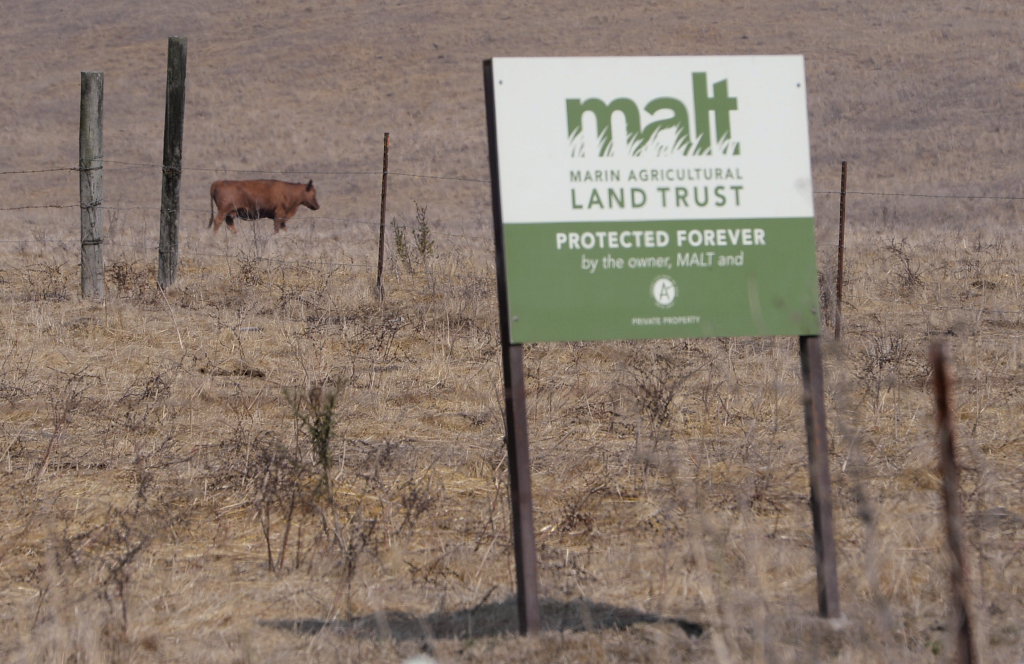
Marin County’s legal office has denied a request to take legal action against the Marin Agricultural Land Trust for the alleged misuse of tax funds.
Ross resident Ken Slayen sought the litigation, claiming the trust used Measure A funds to enrich current and former board members at the public’s expense. MALT denies wrongdoing.
“Based on our review, we are comfortable that the county appropriately, and in compliance with industry standards, reviewed appraisals for the Farmland Preservation Program grants and received appropriate value for the grants that the county issued,” Marin County Counsel Brian Washington wrote in a letter to Slayen’s attorney.
Ray Fort, MALT’s acting executive director, said, “We feel that our position on these issues is clearly vindicated by the county’s response.”
Slayen’s attorney, Thomas Brown, wrote that his client disagrees with the county counsel’s “conclusions and factual assumptions.”
“We now look forward to vindicating in court Mr. Slayen’s efforts to expose MALT’s and Marin’s pervasive misconduct in their misuse of the taxpayers’ Measure A funds,” Brown said.
Slayen, who unsuccessfully sought a conservation easement from the trust in 2015, submitted related requests to the Marin County District Attorney’s Office and the state Fair Political Practices Commission. The commission turned Slayen down. The district attorney has declined to comment on the matter.
Marin voters approved the Measure A sales tax in 2012. The measure mandates that 20% of the revenues are for protecting farmland from development to preserve Marin’s working farms and ranches.
MALT is a nonprofit organization created in 1980 to acquire agricultural conservation easements to permanently protect farmland from development. Since 2014, MALT has received more than $14.8 million in Measure A funds to help purchase agricultural easements. MALT typically purchases conservation easements with an equal split of private donations and public funding.
Landowners who sell to MALT are compensated for agreeing to accept certain limits on what they can do with their properties, such as subdivide them and build homes. Beginning in 2011, MALT also began including mandates in their easements requiring that land continue to be used actively for agriculture.
In his submissions to the county counsel, the district attorney and the Fair Political Practices Commission, Slayen makes two basic allegations.
First, he alleges that several MALT board members have used their positions to improperly influence decisions to acquire conservation easements over properties they own or have a financial interest in.
Second, he asserts that MALT has inflated the value of conservation easements it acquired using Measure A funds in order to benefit present and former board members and their families.
Slayen says the alleged misconduct violated Government Code Section 1090, the Political Reform Act, the Brown Act, the Public Records Act and the California False Claims Act. With the exception of the False Claims Act, all of these laws apply only to public officials and public agencies.
Government Code section 1090 governs conflicts of interest in the making of government contracts. The Political Reform Act was enacted to ensure that public officials perform their duties free from bias caused by their own financial interests.
Slayen requested that the Fair Political Practices Commission initiate administrative or civil proceedings against MALT and 25 of its current or former board members and executives.
“After review of the complaint and evidence provided,” Galena West, the commission’s division chief, wrote in response, “the enforcement division found that the Marin Agricultural Land Trust does not appear to be a government agency under the Political Reform Act, therefore, we will not pursue an enforcement action in this matter.”
Similarly, Washington stated in his letter to Slayen’s lawyer, “We are aware of no authority providing that Government Code Section 1090 governs MALT and therefore will not pursue such an action.”
“On the False Claims Act request, after carefully reviewing the county’s practices on reviewing and accepting appraisals for Measure A grants, we have concluded that the county’s practices ensure that the county receives appropriate value for its Measure A funds,” Washington wrote. “Therefore, the county has no intention of bringing a False Claims Act action, and based on the information received thus far, believes that such an action would have no merit.”
The California False Claims Act was adopted to prevent fraud on the public treasury. The law permits the recovery of civil penalties and damages from any person who knowingly presents a false claim for payment to the state or local governmental entities.
Washington said in his letter that the county has taken steps to further clarify the boundaries separating MALT and the county. The county and MALT have agreed to end the tradition of a member of the Board of Supervisors sitting on the trust’s board of directors. The trust will also change its bylaws so the supervisors no longer appoint two members of the MALT board.
Slayen’s contentious relations with MALT began after his proposal to collaborate with the trust to purchase the Dolcini-Beltrametti Ranch was rejected in 2015. Slayen proposed giving MALT $750,000 to $900,000 toward the acquisition of the 326-acre property. In return, he wanted a tract of about 5 acres that included a house, a small barn and a shed.
To help cover the cost of the purchase, Slayen filed an application for a MALT easement on the property, even though he didn’t own it at the time.
“His original application proposed that he would fund approximately 25 percent of the Beltrametti Ranch property price,” Fort wrote in an email, “and then expected MALT to identify and apply for public funds to support the rest of the property acquisition while he intended to live on the property but not actually farm it.”
In January 2017, Slayen learned that the Earl and Mary Margaret Dolcini Family Trust and the Dolcini Jersey Dairy had purchased the Dolcini-Beltrametti Ranch for $3.2 million. Shortly thereafter, MALT purchased an easement on the property for $1.6 million with assistance from the county. Sam Dolcini is a MALT board member.
At the time, MALT’s conflict-of-interest policy permitted sitting board members to sell easements to the trust but required them to recuse themselves from participating in discussions and voting related to these easement acquisitions.
In a letter to the Fair Political Practices Commission, MALT’s attorney, Ellison Folk, wrote, “Since his application was denied, Mr. Slayen has threatened MALT with litigation.”
Beginning in 2018, Slayen obtained a number of confidential MALT board packets through Public Records Act requests to Marin County. Supervisor Dennis Rodoni was a member of the MALT board at the time.
In July 2019, MALT altered its conflict-of-interest policy. The trust now prohibits sitting board members and their immediate families from selling easements to MALT.
In February of this year, Jeff Stump, the nonprofit’s director of conservation, resigned.
In July, MALT returned $833,250 in Measure A funds that Marin County gave it to help purchase the agricultural easement on the Dolcini-Beltrametti Ranch. The county asked MALT for a refund after the trust notified officials it had failed to disclose an earlier property appraisal that would have reduced the grant.
On July 31, Jamison Watts, MALT’s director, resigned.
In a statement, Fort and Neil Rudolph, chairman of MALT’s board, wrote that the trust raised the appraisal disclosure issue not because it had to but because it was the right thing to do. They added that Watts’ departure was a personal decision unrelated to Slayen’s accusations.
Leslie Ratley-Beach, conservation defense director for the Land Trust Alliance in Washington, D.C., said there is nothing nefarious about a land trust purchasing an easement from one of its directors.
“That happens a lot,” Ratley-Beach said. “If you follow your conflict-of-interest policy and follow your project selection criteria that is very standard. You have board members from the community who are eager to advance the mission of the land trust. They usually own land, that is why they’re interested in the land trust.”
“When I was with the Vermont Land Trust, we did many conservation easements with board members,” she said. “It is a common practice and if done properly it is perfectly legitimate.”
In his submissions, Slayen provides a number of detailed examples of cases in which he believes MALT somehow inflated the value of easements.
Washington, however, wrote, “The county has reviewed the appraisal and valuation information that you provided and disagrees with your conclusion.”
Washington said the examples Slayen provided failed to use the industry standard approach for evaluating appraisals.
“Your letter,” Washington wrote, “looks at appraisals in an entirely different way, plucking isolated facts from multiple different appraisals and trying to compare them as if they were part of a unified valuation analysis.
“It results in an ‘apples to oranges’ kind of comparison that sheds no light on whether the county correctly reviewed the appraisal pursuant to industry standards in entering a Farmland Preservation program grant agreement.”
Several local appraisers with a knowledge of the Marin County market declined to comment on the controversy.
Carl Somers, chief of planning and acquisition for Marin County Parks, said, “Every conservation appraisal is actually two appraisals in one.”
First, the value of the land is appraised with no easements, then it is appraised with the easements.
“Then it’s a subtraction exercise,” Somers said. “You subtract the second number from the first number, and that is how you get the value of the easement.”
Somers said easements have to be treated as integral wholes; they can’t be evaluated by pulling them apart and examining their constituent parts.
“That is not how anyone evaluates an appraisal,” he said.
Ratley-Beach said, “Appraisals by their nature are art and science. They are very dependent on current valuations, on what appraisers call comparables. You can get five appraisers in the room and get 10 different ideas from them on valuation.”










